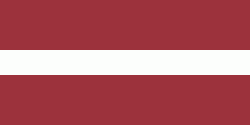Riga District (Rīga)
Riga District (Rīgas rajons) was an administrative division of Latvia, located in Semigallia and Vidzeme regions, in the centre of the country. The district had the two cities of Riga and Jūrmala with the Gulf of Riga to the north. Beginning from the west and counterclockwise to the east, Riga District had Tukums, Jelgava, Bauska, Ogre, Cēsis and Limbaži former districts as neighbours. The area of the district was 3,058 km² with a population of 159,247.
Riga District was one of the largest regions of Latvia, it was strategically important and also had some of the most developed infrastructure in Latvia. It was a cross-point of 10 major motorways and a junction of 6 important railroad lines.
Districts were eliminated during the administrative-territorial reform in 2009.
The larger part of the former region lies in the sand-soil plains of Riga that are covered by pinewoods, low links, marshlands and level countryside that is typical for littoral lowlands. In the northern part, there are ridges of links and many lakes have formed in hollows between them. There are 132 lakes in the Riga Region and the biggest of them is the Babīte Lake, Lielais Baltezers, Mazais Baltezers, Dūņu Lake and Lilaste Lake. The former district is also crossed by three major rivers in Latvia – Daugava, Lielupe and Gauja Rivers.
The north-eastern part of former Riga District is covered by the largest deciduous forests in Latvia. The Gauja National Park is part of these forests and has more than 900 kinds of plants, 48 species of mammals and 149 species of birds.
Riga District was one of the largest regions of Latvia, it was strategically important and also had some of the most developed infrastructure in Latvia. It was a cross-point of 10 major motorways and a junction of 6 important railroad lines.
Districts were eliminated during the administrative-territorial reform in 2009.
The larger part of the former region lies in the sand-soil plains of Riga that are covered by pinewoods, low links, marshlands and level countryside that is typical for littoral lowlands. In the northern part, there are ridges of links and many lakes have formed in hollows between them. There are 132 lakes in the Riga Region and the biggest of them is the Babīte Lake, Lielais Baltezers, Mazais Baltezers, Dūņu Lake and Lilaste Lake. The former district is also crossed by three major rivers in Latvia – Daugava, Lielupe and Gauja Rivers.
The north-eastern part of former Riga District is covered by the largest deciduous forests in Latvia. The Gauja National Park is part of these forests and has more than 900 kinds of plants, 48 species of mammals and 149 species of birds.
Map - Riga District (Rīga)
Map
Country - Latvia
 |
 |
| Flag of Latvia | |
After centuries of Teutonic, Swedish, Polish-Lithuanian and Russian rule, which was mainly executed by the local Baltic German aristocracy, the independent Republic of Latvia was established on 18 November 1918 when it broke away from the German Empire and declared independence in the aftermath of World War I. However, by the 1930s the country became increasingly autocratic after the coup in 1934 establishing an authoritarian regime under Kārlis Ulmanis. The country's de facto independence was interrupted at the outset of World War II, beginning with Latvia's forcible incorporation into the Soviet Union, followed by the invasion and occupation by Nazi Germany in 1941, and the re-occupation by the Soviets in 1944 to form the Latvian SSR for the next 45 years. As a result of extensive immigration during the Soviet occupation, ethnic Russians became the most prominent minority in the country, now constituting nearly a quarter of the population. The peaceful Singing Revolution started in 1987, and ended with the restoration of de facto independence on 21 August 1991. Since then, Latvia has been a democratic unitary parliamentary republic.
Currency / Language
| ISO | Currency | Symbol | Significant figures |
|---|---|---|---|
| EUR | Euro | € | 2 |
| ISO | Language |
|---|---|
| LV | Latvian language |
| LT | Lithuanian language |
| RU | Russian language |















